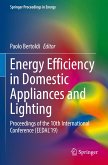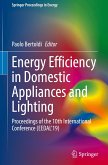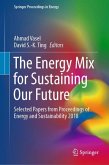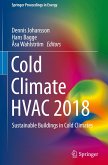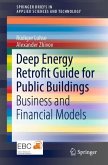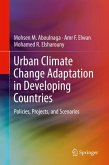Proceedings of the 12th International Conference on Energy Efficiency in Domestic Appliances and Lighting
EEDAL'24, 7-9 October, Kitakyushu City, Japan
Herausgegeben:Bertoldi, Paolo; Gao, Weijun; Xuan, Ji
Proceedings of the 12th International Conference on Energy Efficiency in Domestic Appliances and Lighting
EEDAL'24, 7-9 October, Kitakyushu City, Japan
Herausgegeben:Bertoldi, Paolo; Gao, Weijun; Xuan, Ji
- Gebundenes Buch
- Merkliste
- Auf die Merkliste
- Bewerten Bewerten
- Teilen
- Produkt teilen
- Produkterinnerung
- Produkterinnerung
This book contains peer-reviewed papers presented at the 12th International Conference on Energy Efficiency in Domestic Appliances and Lighting (EEDAL'24), held in Kitakyushu City, Japan from 7-9 October 2024.
Energy efficiency helps to mitigate CO2 emissions and at the same time increases the security of energy supply. Energy efficiency is recognized as the cleanest, quickest and cheapest energy source. Not only this, but energy efficiency brings several additional benefits for society and end-users, such as lower energy costs, reduced local pollution, better outdoor and indoor air…mehr
Andere Kunden interessierten sich auch für
![Energy Efficiency in Domestic Appliances and Lighting Energy Efficiency in Domestic Appliances and Lighting]() Energy Efficiency in Domestic Appliances and Lighting91,99 €
Energy Efficiency in Domestic Appliances and Lighting91,99 €![Energy Efficiency in Domestic Appliances and Lighting Energy Efficiency in Domestic Appliances and Lighting]() Energy Efficiency in Domestic Appliances and Lighting121,99 €
Energy Efficiency in Domestic Appliances and Lighting121,99 €![The Energy Mix for Sustaining Our Future The Energy Mix for Sustaining Our Future]() The Energy Mix for Sustaining Our Future76,99 €
The Energy Mix for Sustaining Our Future76,99 €![Cold Climate HVAC 2018 Cold Climate HVAC 2018]() Cold Climate HVAC 2018154,99 €
Cold Climate HVAC 2018154,99 €![Deep Energy Retrofit Guide for Public Buildings Deep Energy Retrofit Guide for Public Buildings]() Rüdiger LohseDeep Energy Retrofit Guide for Public Buildings38,99 €
Rüdiger LohseDeep Energy Retrofit Guide for Public Buildings38,99 €![Urban Climate Change Adaptation in Developing Countries Urban Climate Change Adaptation in Developing Countries]() Mohsen M. AboulnagaUrban Climate Change Adaptation in Developing Countries76,99 €
Mohsen M. AboulnagaUrban Climate Change Adaptation in Developing Countries76,99 €![Bioclimatic Architecture in Warm Climates Bioclimatic Architecture in Warm Climates]() Bioclimatic Architecture in Warm Climates76,99 €
Bioclimatic Architecture in Warm Climates76,99 €-
-
-
This book contains peer-reviewed papers presented at the 12th International Conference on Energy Efficiency in Domestic Appliances and Lighting (EEDAL'24), held in Kitakyushu City, Japan from 7-9 October 2024.
Energy efficiency helps to mitigate CO2 emissions and at the same time increases the security of energy supply. Energy efficiency is recognized as the cleanest, quickest and cheapest energy source. Not only this, but energy efficiency brings several additional benefits for society and end-users, such as lower energy costs, reduced local pollution, better outdoor and indoor air quality, etc.
However, in some sectors, such as the residential sector, barriers to investments in energy efficiency remain. Legislation adopted in several jurisdictions (EU, Japan, USA, China, India, Australia, Brazil, etc.) helps in removing barriers and fosters investments in energy efficiency. These initiatives complement innovative financing schemes for energy efficiency, the provision of energy services by energy service companies and different types of information programs. At the same time, progress in appliance technologies and in solid state lighting offer high levels of efficiency. LED lighting is an example.
As with previous conferences in this series, EEDAL 24 provided a unique forum to discuss and debate the latest developments in energy and environmental impact of households, including appliances, lighting, heating and cooling equipment, electronics, smart meters, consumer behavior, new technology developments, policies, and programs. In addition, EEDAL also addressed non-technical issues such as consumer behavior, energy access in developing countries, and demand response.
Energy efficiency helps to mitigate CO2 emissions and at the same time increases the security of energy supply. Energy efficiency is recognized as the cleanest, quickest and cheapest energy source. Not only this, but energy efficiency brings several additional benefits for society and end-users, such as lower energy costs, reduced local pollution, better outdoor and indoor air quality, etc.
However, in some sectors, such as the residential sector, barriers to investments in energy efficiency remain. Legislation adopted in several jurisdictions (EU, Japan, USA, China, India, Australia, Brazil, etc.) helps in removing barriers and fosters investments in energy efficiency. These initiatives complement innovative financing schemes for energy efficiency, the provision of energy services by energy service companies and different types of information programs. At the same time, progress in appliance technologies and in solid state lighting offer high levels of efficiency. LED lighting is an example.
As with previous conferences in this series, EEDAL 24 provided a unique forum to discuss and debate the latest developments in energy and environmental impact of households, including appliances, lighting, heating and cooling equipment, electronics, smart meters, consumer behavior, new technology developments, policies, and programs. In addition, EEDAL also addressed non-technical issues such as consumer behavior, energy access in developing countries, and demand response.
Produktdetails
- Produktdetails
- Springer Proceedings in Energy
- Verlag: Springer, Berlin; Springer
- Artikelnr. des Verlages: 89550634
- Seitenzahl: 742
- Erscheinungstermin: 12. Februar 2026
- Englisch
- Abmessung: 235mm x 155mm
- ISBN-13: 9783032109736
- ISBN-10: 3032109736
- Artikelnr.: 75608365
- Herstellerkennzeichnung
- Springer-Verlag GmbH
- Tiergartenstr. 17
- 69121 Heidelberg
- ProductSafety@springernature.com
- Springer Proceedings in Energy
- Verlag: Springer, Berlin; Springer
- Artikelnr. des Verlages: 89550634
- Seitenzahl: 742
- Erscheinungstermin: 12. Februar 2026
- Englisch
- Abmessung: 235mm x 155mm
- ISBN-13: 9783032109736
- ISBN-10: 3032109736
- Artikelnr.: 75608365
- Herstellerkennzeichnung
- Springer-Verlag GmbH
- Tiergartenstr. 17
- 69121 Heidelberg
- ProductSafety@springernature.com
Paolo Bertoldi is a senior expert in sustainable energy, climate change, and energy efficiency policies at the European Commission. Some key areas of his expertise include energy service companies, market based instruments, energy and climate policy analysis, environmental leadership, and ICT energy consumption. Dr. Bertoldi holds a doctorate in electrical engineering from the University of Padova. He is also the Editor-in-Chief of Springer's Energy Efficiency journal. He has published over 100 papers in leading academic journals, such as Energy Economics, Energy Policy, Renewable and Sustainable Energy Reviews, Climate Policy, Energy, Energy and Buildings, Journal of Cleaner Production, Nature Climate, One Earth, etc. Weijun Gao is a tenured professor at the University of Kitakyushu, Japan and an academia professor at Qingdao University of Technology, China. His research interests include the science, engineering, management, and dissemination of city environment planning, distributed energy systems, recycling building materials, health and environmental impacts of energy generation, geographic information systems, and climate change, especially in urban areas. Ji Xuan is a Senior Researcher at the Jyukankyo Research Institute (JYURI), where she has been working for over 15 years. Her recent research focuses on the analysis and forecasting of energy consumption in the residential and commercial sectors towards 2050, the operation and management of the Zero Energy Houses (ZEH) Committee, and the support of government-led subsidy programs in Japan that promote energy-efficient renovations of existing homes and the adoption of high-efficiency water heating systems. She has extensive experience in analyzing and evaluating energy conservation policies and measures in major countries worldwide, contributing to policy recommendations from an international perspective. She holds a bachelors degree in architectural environmental engineering from the Jilin Institute of Architecture and Civil Engineering in China, and both a masters degree and a Ph.D. in the same fields from the University of Kitakyushu in Japan. In addition, she delivers special lectures at Waseda University in Japan on energy and the built environment.
20% energy saving by following simple consumer recommendations in using the
dishwasher.- Investigating the Impacts of Consumers Behaviors on Lighting
Consumption.- Initial environmental assessment of an innovative fuel cell
microgeneration system for multifamily buildings.- Simulating Lighting
Energy Consumption in Office Buildings by Exploring the Relationship
Between Environmental Psychological Factors and Occupant Behavior.- New EU
Ecodesign criteria supporting longer product lifetimes when is lifetime
extension preferable for reducing environmental impacts.- Understanding
consumer usage to design new products and the right recommendations of use
example energy of dishwashing in Australia.- Appliance energy efficiency
and climate change Absolute MEPS and energy sufficiency.- Behavioral
Patterns in Home Energy Reports Seasonal and Regional Analysis in Japan s
Varied Climates.- Pathway to high efficiency water heating a comparison
testing for three types of water heaters with a unified energy efficiency
testing method in China.- Bridging the Cooling Gap Energy Efficiency as a
Driver for Appliance Access.- Cooling the World Sustainably Evaluating the
Impact of Energy Efficiency Labeling Policies on Room Air Conditioning
Efficiency in China and Brazil.- New power electronics to reach next level
of energy efficiency in equipment Results from the IEA 4E PECTA platform s
first term.- Rescaling Energy Labels for Carbon Emissions Reduction A
Comparison of Global and China Policies and Impact Assessment.- RESEARCH ON
UNDERFLOOR DUCTED HEATING HOUSES WITH AIR-BASED PVT PANEL ON THE ROOFS
INVESTIGATION OF COST-EFFECTIVE FOUNDATION INSULATION SPECIFICATIONS.-
Energy Storage through Water Heaters to Support Renewables in Residential
Segments.- Technical support for the performance test of air conditioners
in ASEAN testing laboratories.- Using Smart Gauges to Support Impact
Evaluations for Delivered Fuels.- Reminders Recommendations of Survey
Basics Improving Quality and Reducing Bias in Web Surveys for Evaluation
Attitudes and Other Purposes.- Closing the Energy Gap Optimizing Energy
Savings Using Proven Economic Methods.- Development Of Control Device to
Use Air Conditioners During Power Shortage.- Measurement and evaluation of
the energy efficiency effect of shifting the operation time of a heat pump
water heater.- Recognition as a Strategy to Standardize Credentials and
Empower the Energy Efficiency Workforce.- Playify your public product data
benefits and pitfalls of using games to change consumer behaviour.-
Prediction of Net Energy Demand for the Management of Transactive Energy
Communities.- Flexible Demand Priority loads and potential impacts for
Australia.- Oikia An awareness action focused on behaviour change in
households who have recently installed energy efficiency measures.-
Uncovering Hidden Demand Flexibility Using Non-Intrusive Load Monitoring
(NILM): A Case for Southern Africa Preliminary Results for Erongo RED
Namibia.- Scalable Window Retrofit Solutions for Multi Family Buildings in
the United States.- Small Steps Big Savings Energy Saving Tips to Cut Your
Utility Bill.- Common goals but differentiated pathways findings from a
comparative study of policies for energy efficiency in residential
buildings in Germany EU and Japan.- Lifecycle Refrigerant Management.-
Occupancy Fan Controllers.- Demonstration of Regional Energy Management.-
Application of Physiological Sensing Technology in Indoor Environmental
Quality Assessment.- Using broadcasting infrastructures to control the
flexibility of electricity consumption in real time The case of the
FLEXIMAX project.- Introduction of Whole of Home Energy Efficiency
Standards into the Australian National Construction Code.- ChargeDEM
Geodemographic Aware EV Charging Infrastructure Placement for Enhanced Site
Selection using Graph Neural Networks.- Heating with Air Conditioners Swiss
Case Studies.- Research on the Influence of Architectural Orientation on
Natural Lighting of Residential Buildings and Its Optimization Design.-
Research On Indoor Thermal Environment of Colleges and Universities in
Summer in Hot and Dry Areas.- The use status and optimization strategy of
equipment in a large exhibition building in summer.- Eye Tracking
Technology in Architectural Design.- Forecasting spot market prices for
residential prosumers based on a deep learning model.
dishwasher.- Investigating the Impacts of Consumers Behaviors on Lighting
Consumption.- Initial environmental assessment of an innovative fuel cell
microgeneration system for multifamily buildings.- Simulating Lighting
Energy Consumption in Office Buildings by Exploring the Relationship
Between Environmental Psychological Factors and Occupant Behavior.- New EU
Ecodesign criteria supporting longer product lifetimes when is lifetime
extension preferable for reducing environmental impacts.- Understanding
consumer usage to design new products and the right recommendations of use
example energy of dishwashing in Australia.- Appliance energy efficiency
and climate change Absolute MEPS and energy sufficiency.- Behavioral
Patterns in Home Energy Reports Seasonal and Regional Analysis in Japan s
Varied Climates.- Pathway to high efficiency water heating a comparison
testing for three types of water heaters with a unified energy efficiency
testing method in China.- Bridging the Cooling Gap Energy Efficiency as a
Driver for Appliance Access.- Cooling the World Sustainably Evaluating the
Impact of Energy Efficiency Labeling Policies on Room Air Conditioning
Efficiency in China and Brazil.- New power electronics to reach next level
of energy efficiency in equipment Results from the IEA 4E PECTA platform s
first term.- Rescaling Energy Labels for Carbon Emissions Reduction A
Comparison of Global and China Policies and Impact Assessment.- RESEARCH ON
UNDERFLOOR DUCTED HEATING HOUSES WITH AIR-BASED PVT PANEL ON THE ROOFS
INVESTIGATION OF COST-EFFECTIVE FOUNDATION INSULATION SPECIFICATIONS.-
Energy Storage through Water Heaters to Support Renewables in Residential
Segments.- Technical support for the performance test of air conditioners
in ASEAN testing laboratories.- Using Smart Gauges to Support Impact
Evaluations for Delivered Fuels.- Reminders Recommendations of Survey
Basics Improving Quality and Reducing Bias in Web Surveys for Evaluation
Attitudes and Other Purposes.- Closing the Energy Gap Optimizing Energy
Savings Using Proven Economic Methods.- Development Of Control Device to
Use Air Conditioners During Power Shortage.- Measurement and evaluation of
the energy efficiency effect of shifting the operation time of a heat pump
water heater.- Recognition as a Strategy to Standardize Credentials and
Empower the Energy Efficiency Workforce.- Playify your public product data
benefits and pitfalls of using games to change consumer behaviour.-
Prediction of Net Energy Demand for the Management of Transactive Energy
Communities.- Flexible Demand Priority loads and potential impacts for
Australia.- Oikia An awareness action focused on behaviour change in
households who have recently installed energy efficiency measures.-
Uncovering Hidden Demand Flexibility Using Non-Intrusive Load Monitoring
(NILM): A Case for Southern Africa Preliminary Results for Erongo RED
Namibia.- Scalable Window Retrofit Solutions for Multi Family Buildings in
the United States.- Small Steps Big Savings Energy Saving Tips to Cut Your
Utility Bill.- Common goals but differentiated pathways findings from a
comparative study of policies for energy efficiency in residential
buildings in Germany EU and Japan.- Lifecycle Refrigerant Management.-
Occupancy Fan Controllers.- Demonstration of Regional Energy Management.-
Application of Physiological Sensing Technology in Indoor Environmental
Quality Assessment.- Using broadcasting infrastructures to control the
flexibility of electricity consumption in real time The case of the
FLEXIMAX project.- Introduction of Whole of Home Energy Efficiency
Standards into the Australian National Construction Code.- ChargeDEM
Geodemographic Aware EV Charging Infrastructure Placement for Enhanced Site
Selection using Graph Neural Networks.- Heating with Air Conditioners Swiss
Case Studies.- Research on the Influence of Architectural Orientation on
Natural Lighting of Residential Buildings and Its Optimization Design.-
Research On Indoor Thermal Environment of Colleges and Universities in
Summer in Hot and Dry Areas.- The use status and optimization strategy of
equipment in a large exhibition building in summer.- Eye Tracking
Technology in Architectural Design.- Forecasting spot market prices for
residential prosumers based on a deep learning model.
20% energy saving by following simple consumer recommendations in using the
dishwasher.- Investigating the Impacts of Consumers Behaviors on Lighting
Consumption.- Initial environmental assessment of an innovative fuel cell
microgeneration system for multifamily buildings.- Simulating Lighting
Energy Consumption in Office Buildings by Exploring the Relationship
Between Environmental Psychological Factors and Occupant Behavior.- New EU
Ecodesign criteria supporting longer product lifetimes when is lifetime
extension preferable for reducing environmental impacts.- Understanding
consumer usage to design new products and the right recommendations of use
example energy of dishwashing in Australia.- Appliance energy efficiency
and climate change Absolute MEPS and energy sufficiency.- Behavioral
Patterns in Home Energy Reports Seasonal and Regional Analysis in Japan s
Varied Climates.- Pathway to high efficiency water heating a comparison
testing for three types of water heaters with a unified energy efficiency
testing method in China.- Bridging the Cooling Gap Energy Efficiency as a
Driver for Appliance Access.- Cooling the World Sustainably Evaluating the
Impact of Energy Efficiency Labeling Policies on Room Air Conditioning
Efficiency in China and Brazil.- New power electronics to reach next level
of energy efficiency in equipment Results from the IEA 4E PECTA platform s
first term.- Rescaling Energy Labels for Carbon Emissions Reduction A
Comparison of Global and China Policies and Impact Assessment.- RESEARCH ON
UNDERFLOOR DUCTED HEATING HOUSES WITH AIR-BASED PVT PANEL ON THE ROOFS
INVESTIGATION OF COST-EFFECTIVE FOUNDATION INSULATION SPECIFICATIONS.-
Energy Storage through Water Heaters to Support Renewables in Residential
Segments.- Technical support for the performance test of air conditioners
in ASEAN testing laboratories.- Using Smart Gauges to Support Impact
Evaluations for Delivered Fuels.- Reminders Recommendations of Survey
Basics Improving Quality and Reducing Bias in Web Surveys for Evaluation
Attitudes and Other Purposes.- Closing the Energy Gap Optimizing Energy
Savings Using Proven Economic Methods.- Development Of Control Device to
Use Air Conditioners During Power Shortage.- Measurement and evaluation of
the energy efficiency effect of shifting the operation time of a heat pump
water heater.- Recognition as a Strategy to Standardize Credentials and
Empower the Energy Efficiency Workforce.- Playify your public product data
benefits and pitfalls of using games to change consumer behaviour.-
Prediction of Net Energy Demand for the Management of Transactive Energy
Communities.- Flexible Demand Priority loads and potential impacts for
Australia.- Oikia An awareness action focused on behaviour change in
households who have recently installed energy efficiency measures.-
Uncovering Hidden Demand Flexibility Using Non-Intrusive Load Monitoring
(NILM): A Case for Southern Africa Preliminary Results for Erongo RED
Namibia.- Scalable Window Retrofit Solutions for Multi Family Buildings in
the United States.- Small Steps Big Savings Energy Saving Tips to Cut Your
Utility Bill.- Common goals but differentiated pathways findings from a
comparative study of policies for energy efficiency in residential
buildings in Germany EU and Japan.- Lifecycle Refrigerant Management.-
Occupancy Fan Controllers.- Demonstration of Regional Energy Management.-
Application of Physiological Sensing Technology in Indoor Environmental
Quality Assessment.- Using broadcasting infrastructures to control the
flexibility of electricity consumption in real time The case of the
FLEXIMAX project.- Introduction of Whole of Home Energy Efficiency
Standards into the Australian National Construction Code.- ChargeDEM
Geodemographic Aware EV Charging Infrastructure Placement for Enhanced Site
Selection using Graph Neural Networks.- Heating with Air Conditioners Swiss
Case Studies.- Research on the Influence of Architectural Orientation on
Natural Lighting of Residential Buildings and Its Optimization Design.-
Research On Indoor Thermal Environment of Colleges and Universities in
Summer in Hot and Dry Areas.- The use status and optimization strategy of
equipment in a large exhibition building in summer.- Eye Tracking
Technology in Architectural Design.- Forecasting spot market prices for
residential prosumers based on a deep learning model.
dishwasher.- Investigating the Impacts of Consumers Behaviors on Lighting
Consumption.- Initial environmental assessment of an innovative fuel cell
microgeneration system for multifamily buildings.- Simulating Lighting
Energy Consumption in Office Buildings by Exploring the Relationship
Between Environmental Psychological Factors and Occupant Behavior.- New EU
Ecodesign criteria supporting longer product lifetimes when is lifetime
extension preferable for reducing environmental impacts.- Understanding
consumer usage to design new products and the right recommendations of use
example energy of dishwashing in Australia.- Appliance energy efficiency
and climate change Absolute MEPS and energy sufficiency.- Behavioral
Patterns in Home Energy Reports Seasonal and Regional Analysis in Japan s
Varied Climates.- Pathway to high efficiency water heating a comparison
testing for three types of water heaters with a unified energy efficiency
testing method in China.- Bridging the Cooling Gap Energy Efficiency as a
Driver for Appliance Access.- Cooling the World Sustainably Evaluating the
Impact of Energy Efficiency Labeling Policies on Room Air Conditioning
Efficiency in China and Brazil.- New power electronics to reach next level
of energy efficiency in equipment Results from the IEA 4E PECTA platform s
first term.- Rescaling Energy Labels for Carbon Emissions Reduction A
Comparison of Global and China Policies and Impact Assessment.- RESEARCH ON
UNDERFLOOR DUCTED HEATING HOUSES WITH AIR-BASED PVT PANEL ON THE ROOFS
INVESTIGATION OF COST-EFFECTIVE FOUNDATION INSULATION SPECIFICATIONS.-
Energy Storage through Water Heaters to Support Renewables in Residential
Segments.- Technical support for the performance test of air conditioners
in ASEAN testing laboratories.- Using Smart Gauges to Support Impact
Evaluations for Delivered Fuels.- Reminders Recommendations of Survey
Basics Improving Quality and Reducing Bias in Web Surveys for Evaluation
Attitudes and Other Purposes.- Closing the Energy Gap Optimizing Energy
Savings Using Proven Economic Methods.- Development Of Control Device to
Use Air Conditioners During Power Shortage.- Measurement and evaluation of
the energy efficiency effect of shifting the operation time of a heat pump
water heater.- Recognition as a Strategy to Standardize Credentials and
Empower the Energy Efficiency Workforce.- Playify your public product data
benefits and pitfalls of using games to change consumer behaviour.-
Prediction of Net Energy Demand for the Management of Transactive Energy
Communities.- Flexible Demand Priority loads and potential impacts for
Australia.- Oikia An awareness action focused on behaviour change in
households who have recently installed energy efficiency measures.-
Uncovering Hidden Demand Flexibility Using Non-Intrusive Load Monitoring
(NILM): A Case for Southern Africa Preliminary Results for Erongo RED
Namibia.- Scalable Window Retrofit Solutions for Multi Family Buildings in
the United States.- Small Steps Big Savings Energy Saving Tips to Cut Your
Utility Bill.- Common goals but differentiated pathways findings from a
comparative study of policies for energy efficiency in residential
buildings in Germany EU and Japan.- Lifecycle Refrigerant Management.-
Occupancy Fan Controllers.- Demonstration of Regional Energy Management.-
Application of Physiological Sensing Technology in Indoor Environmental
Quality Assessment.- Using broadcasting infrastructures to control the
flexibility of electricity consumption in real time The case of the
FLEXIMAX project.- Introduction of Whole of Home Energy Efficiency
Standards into the Australian National Construction Code.- ChargeDEM
Geodemographic Aware EV Charging Infrastructure Placement for Enhanced Site
Selection using Graph Neural Networks.- Heating with Air Conditioners Swiss
Case Studies.- Research on the Influence of Architectural Orientation on
Natural Lighting of Residential Buildings and Its Optimization Design.-
Research On Indoor Thermal Environment of Colleges and Universities in
Summer in Hot and Dry Areas.- The use status and optimization strategy of
equipment in a large exhibition building in summer.- Eye Tracking
Technology in Architectural Design.- Forecasting spot market prices for
residential prosumers based on a deep learning model.


